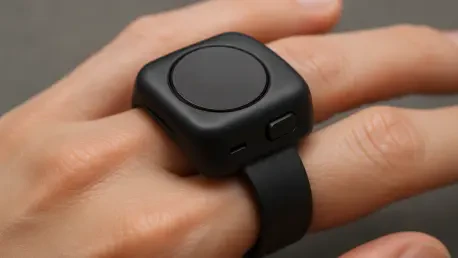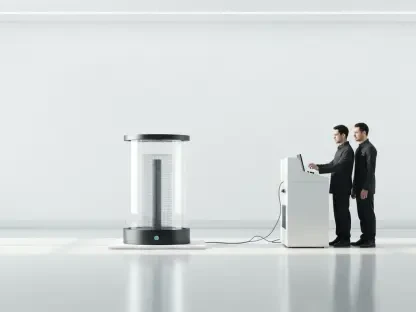Imagine navigating a virtual reality environment or interacting with augmented reality glasses without the cumbersome need for a traditional mouse or bulky handheld controller. In a world where wearable technology is rapidly becoming integral to daily life, the demand for seamless, intuitive input devices has never been higher. Enter the PicoRing, a revolutionary finger-worn wireless mouse designed to bridge the gap between convenience and functionality in AR and VR settings. This review dives deep into the innovative features of this ultralow-power device, evaluates its real-world performance, and explores its potential to redefine how users engage with wearable tech.
Unveiling a New Era of Input Devices
The PicoRing stands out as a pioneering solution in the realm of wearable input technology. Designed as a ring-based wireless mouse, it offers a discreet and compact alternative to conventional input methods, particularly for desk-free or hands-free scenarios. Its primary purpose is to facilitate interaction with wearable devices like AR glasses, where traditional mice fall short due to their stationary nature.
This technology emerges at a pivotal time when AR and VR systems are gaining mainstream traction. The need for intuitive control mechanisms that don’t hinder mobility has spurred innovation, and the PicoRing positions itself as a response to this challenge. By fitting comfortably on a finger, it promises to blend seamlessly into daily activities without drawing attention in public spaces.
Unlike many smart rings that struggle with power constraints and design bulkiness, this device introduces a fresh approach to wearable control. Its focus on energy efficiency and user convenience sets a new benchmark, hinting at a future where interacting with digital interfaces could be as natural as a flick of the wrist.
Core Features and Technical Breakthroughs
Unmatched Energy Efficiency
One of the standout attributes of the PicoRing is its ultralow-power design, which allows for an extraordinary battery life of over a month on a single charge. This achievement is made possible through a cutting-edge semi-passive inductive telemetry system, a method that drastically cuts power consumption to a mere 30–500 microwatts. Unlike typical smart rings that rely on energy-intensive communication methods, this system uses distributed capacitors to amplify magnetic fields without active signal boosters.
This innovation not only extends the device’s usability but also addresses a common pain point in wearable tech: frequent recharging. For users constantly on the move, whether in professional AR applications or immersive VR gaming, this long-lasting power offers a significant advantage, reducing downtime and enhancing productivity.
The implications of such efficiency are profound, setting a precedent for other wearable devices to prioritize sustainability in power usage. As battery technology often lags behind other advancements, the PicoRing’s approach could inspire broader industry shifts toward more enduring solutions.
Innovative Wristband Relay Mechanism
Complementing the ring’s power-saving design is a wristband relay system, an essential component that manages signal transmission between the PicoRing and the target device. This mechanism offloads much of the energy burden from the ring itself, further conserving power while ensuring reliable communication. It interprets varying signal frequencies to execute actions like scrolling or pressing, making interactions smooth and responsive.
The wristband’s role is critical in maintaining the device’s lightweight profile, weighing in at just 5 grams. However, its necessity also introduces a dependency, as the ring’s functionality hinges on wearing this additional accessory. Researchers have optimized the ring’s signal coils to perform best at a natural wearing angle, enhancing user experience by aligning with instinctive hand positions.
While effective, this setup underscores a balance between innovation and practicality. The relay system exemplifies clever engineering but also highlights areas for potential refinement, such as integrating its functions directly into the ring to streamline the user experience.
Trends Shaping Wearable Input Solutions
The rise of AR and VR technologies has catalyzed a surge in demand for compact, hands-free input devices, a trend that the PicoRing directly addresses. As these systems become more embedded in industries ranging from gaming to healthcare, the limitations of traditional input tools become increasingly apparent. Wearable controllers like rings are emerging as viable alternatives, offering discretion and mobility in public or dynamic settings.
Energy efficiency remains a critical focus within this landscape, with many smart rings and wearables struggling to balance functionality with battery life. The PicoRing’s ultralow-power consumption positions it as a frontrunner in tackling this challenge, potentially paving the way for similar advancements across the sector. Its design philosophy aligns with a growing emphasis on sustainable tech solutions.
Moreover, user convenience is shaping the direction of wearable innovation. Devices that integrate seamlessly into everyday life without adding bulk or complexity are gaining favor, and the PicoRing’s minimalist approach reflects this shift. As consumer expectations evolve, such technologies could redefine standards for what constitutes an effective input device in modern contexts.
Practical Applications in Real-World Settings
In AR and VR environments, where interacting with virtual interfaces often requires unconventional input methods, the PicoRing excels as a practical tool. It enables users to navigate menus, select options, and engage with digital content effortlessly, all without the constraints of a desk or wired setup. This makes it particularly valuable for professionals using AR for fieldwork or gamers immersed in VR simulations.
Beyond its primary role, the device shows promise in secondary applications such as health monitoring. Its close contact with the skin opens possibilities for tracking vital signs like heart rate, adding a layer of functionality that could appeal to a broader audience. This dual-purpose potential hints at a future where wearables serve multiple needs simultaneously.
The versatility of the PicoRing underscores its relevance in a market increasingly focused on multifunctional devices. While currently tailored for niche uses, its adaptability suggests a capacity to evolve into a more comprehensive tool, potentially impacting areas beyond digital interaction and into personal wellness.
Addressing Challenges and Limitations
Despite its innovations, the PicoRing faces several hurdles that temper its current appeal. Its design, though lightweight at 5 grams, is still perceived as somewhat bulky for a ring, which could affect comfort during extended wear. For users accustomed to sleek, unobtrusive jewelry, this aspect may detract from the overall experience.
Wireless interference poses another concern, particularly in crowded or signal-heavy environments where connectivity might falter. This vulnerability could disrupt functionality at critical moments, a significant drawback for applications requiring consistent performance. Additionally, the device’s reliance on a wristband relay introduces an extra step in setup, potentially seen as an inconvenience by some users.
Functionality is also limited to basic actions like scrolling and pressing, lacking support for more complex gestures or interactions. Ongoing research aims to address these issues through design refinements and advancements in areas like electronic textiles, which could eventually eliminate the need for a separate relay. Until then, these constraints highlight the prototype nature of the device.
Looking Ahead: The Future of Wearable Control
The trajectory of the PicoRing suggests a promising path forward, with potential enhancements in comfort and interference resistance on the horizon. Future iterations could refine the ring’s form factor to be less intrusive, making it more akin to everyday accessories. Such improvements would likely broaden its appeal beyond early adopters to a mainstream audience.
Expanding functionality to include diverse gesture recognition is another area of focus, which could elevate the device’s utility for intricate tasks. Integrating health monitoring capabilities remains a long-term goal, positioning the PicoRing as a multifaceted wearable that combines control with personal health insights. These developments could significantly enhance its market position.
The broader impact of this technology on wearable innovation cannot be understated. By demonstrating the feasibility of ultralow-power designs, it may inspire a wave of similar solutions, pushing the boundaries of what wearables can achieve. As research progresses, the PicoRing could serve as a catalyst for reimagining human-computer interaction in increasingly mobile and digital landscapes.
Reflecting on the Journey
Looking back, the evaluation of the PicoRing revealed a device that broke new ground with its ultralow-power consumption and month-long battery life, setting a high standard for wearable input solutions. Its seamless integration into AR and VR contexts showcased a clear strength, while limitations like design bulkiness and basic functionality underscored its status as a work in progress. The balance between innovation and practicality was evident throughout the assessment.
Moving forward, actionable steps include prioritizing user testing in varied real-world scenarios to refine comfort and reliability. Collaborations with material scientists could yield breakthroughs in reducing the device’s footprint, while partnerships with health tech firms might accelerate the integration of monitoring features. These efforts would address current shortcomings and expand the PicoRing’s relevance.
As the wearable tech landscape continues to evolve, keeping an eye on emerging standards and user expectations will be crucial. Exploring compatibility with a wider range of devices and platforms could further solidify the PicoRing’s position. Ultimately, sustained investment in research and development promises to transform this prototype into a cornerstone of future digital interaction, offering a glimpse into a more intuitive and connected world.









